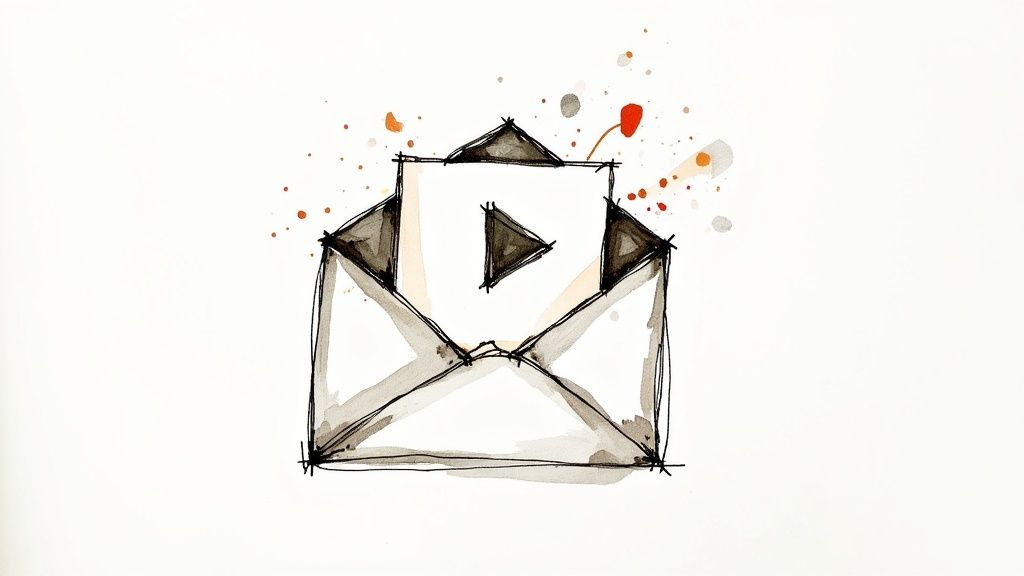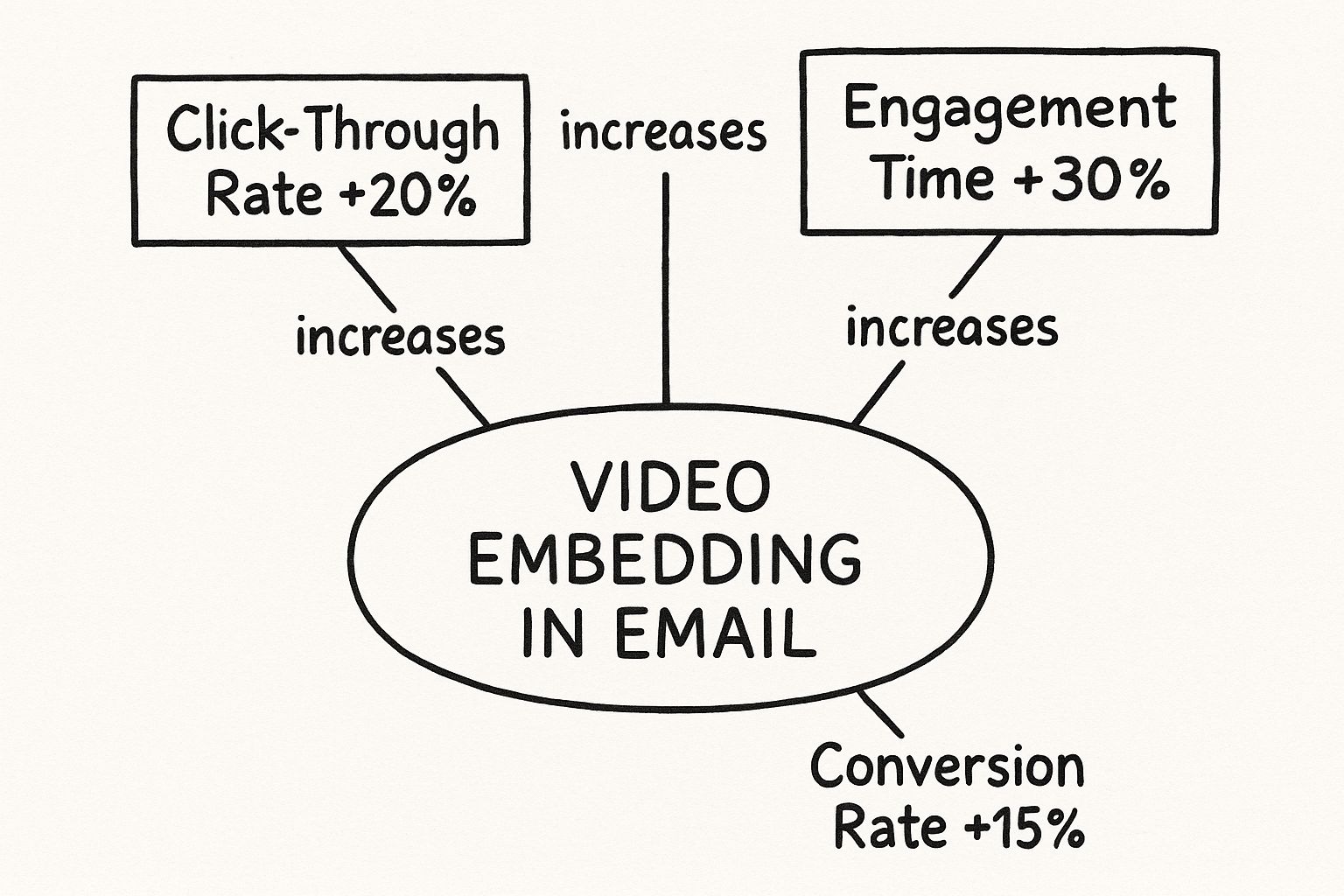
A Guide to Videos in Email Marketing
Putting videos in email marketing is like swapping a black-and-white photo for a live-action movie. It instantly turns a flat, static message into a dynamic experience that grabs your subscribers' attention and makes your campaigns far more memorable than plain old text.
Why Videos in Email Marketing Are a Game-Changer

Just think about your own inbox for a second. It's a battlefield. Dozens of emails are all screaming for a few seconds of your time, and a text-based message has to fight tooth and nail just to get noticed.
But what happens when you drop in a video thumbnail with a big, clickable play button? The whole dynamic changes. You're not just sending information anymore; you're offering an experience that’s easier and more enjoyable to consume.
This isn’t just about adding some visual sparkle. It's about tapping into how we're wired to communicate. Videos are incredibly effective because they can:
- Show, Don't Just Tell: A genuine smile or an enthusiastic product demo creates a human connection that words on a screen just can't match. You’re building a real relationship.
- Make Complex Ideas Simple: Trying to explain how your new software feature works? A 60-second video can do the job of a ten-page guide, showing the process far more clearly than text ever could.
- Build Real Trust: When you put a face to your brand, you become more relatable. A customer testimonial or a peek behind the scenes feels authentic and builds the confidence people need before they buy.
The Undeniable Impact on Performance
The numbers don't lie. Simply including the word "video" in an email subject line can get more people to open it, but embedding a video thumbnail can skyrocket your results.
In fact, using video has been shown to boost click-through rates by a staggering 200-300%. What's more, brands that make video a core part of their marketing see their revenue grow 49% faster than those who don’t. That's a serious impact on the bottom line.
Just as real estate agents use the power of cinematic HD video to make properties look irresistible, you can apply high-quality video to your emails for the same "wow" factor.
A video doesn't just decorate your email; it changes what the email is. It goes from being a static notification to an interactive doorway, inviting your subscribers to step into a richer brand experience.
Ultimately, every email has a goal. You want your subscriber to make a purchase, register for an event, or just learn more about what you do. Video is the perfect catalyst. It grabs attention, holds it, and makes that next step feel natural and compelling. This even works for building your audience in the first place, as you can see how video can help you gain email subscribers in our other guide.
Understanding How Video Works in Email
So, you want to put a video in your email? It probably sounds like a technical nightmare, but it’s actually more straightforward than you might think. The big secret is that you’re not actually attaching a heavy video file like you would a PDF. That would send your subscribers’ inboxes into a meltdown.
Instead, we’re using a few clever tricks to get that video in front of them. Think of it like inviting someone to a party. You wouldn't try to stuff the entire party into an envelope. You'd send a cool-looking invitation with a picture of the fun inside and a map to get there. That's exactly what we're doing here.
The Three Core Methods for Including Video
When you add a video to an email campaign, you’ll generally pick from one of three go-to methods. Each one is a balance between creating a slick user experience and dealing with the quirky technical rules of different email clients like Gmail, Outlook, and Apple Mail.
Let’s break them down:
- Static Image with a Play Button: This is the most popular kid in school for a reason—it just works. Everywhere. You take a really compelling screenshot from your video, slap a big "play" icon on it, and link the whole image to where your video lives online. Simple, reliable, and foolproof.
- Animated GIF: This method gives a little taste of the action. You create a short, silent, looping clip from your video and pop it in the email as a GIF. Just like the static image, you link the GIF to your full video. It’s fantastic for grabbing attention because our eyes are naturally drawn to movement.
- HTML5 Embedded Video: This is the most direct route, letting the video play right inside the email client. It's a seamless experience, but—and it's a big but—support is pretty limited. It works beautifully in places like Apple Mail, but it's a no-go for major players like Gmail and most versions of Outlook. You absolutely need a fallback (like a static image) for this to be viable.
Since direct embedding can be so hit-or-miss, most marketers stick with the first two options. They deliver a consistent, engaging experience for everyone on your list, so you don't have to worry about anyone seeing a broken email.
The real goal isn't just to send a video; it's to get people to watch it. A clickable thumbnail or a slick animated GIF is often the best way to get that click, promising a great experience with zero technical drama for your subscriber.
This infographic lays out just how much of a difference embedding a video can make to your core marketing metrics.

As you can see, the numbers speak for themselves. With major bumps in click-throughs, time spent engaging, and conversions, video is a seriously powerful tool for getting your audience to take action.
Comparing Video in Email Implementation Methods
To make the choice crystal clear, here's a quick breakdown of how these three methods stack up against each other. This table should help you decide which approach is the right fit for your next campaign based on your goals and your audience.
Ultimately, picking the right "invitation" style comes down to what you want to achieve. The static image is your safest bet for universal appeal. The animated GIF is your best friend for sparking curiosity and driving up click-through rates. And HTML5 embedding? Save that for special occasions when you know your audience is using a client that will play ball, like Apple Mail users.
Proven Strategies for High-Impact Video Emails

Knowing how to pop a video into an email is one thing. But the real secret sauce? Knowing what kind of video to create in the first place. The most successful campaigns don't just happen to have a video; they're built around it.
Think of your video as the main event of your email. Everything else—your subject line, the preview text, the copy—is just the opening act, building excitement and giving people a reason to hit that play button. Get this right, and your email stops being just another notification and becomes something people genuinely want to see.
This means you have to move past generic clips. Instead, focus on creating content that offers real value, forges a connection, and nudges people to act. It all starts with matching the right video to the right goal.
Match Your Video Type to Your Campaign Goal
Different videos do different jobs. Picking the right format is your first real step toward making something that actually connects with your audience. Don't just make a video because you think you should; make one with a clear purpose that serves both your subscribers and your business.
Here are a few powerful video types and how you can put them to work in your next email campaign:
- Personalized Sales Messages: Imagine a new lead opens an email and sees a short video of a sales rep greeting them by name, maybe even mentioning their specific interests. This kind of personal touch completely shatters the robotic feel of most outreach, building instant trust and rapport.
- Product Demos and Feature Announcements: Why describe a new feature with a wall of text when you can show it off? A quick, 60-second screen recording can prove its value much more effectively, making even complex features feel intuitive and exciting.
- Behind-the-Scenes Content: Give your subscribers a peek behind the curtain. Show them your company culture, how your product gets made, or a day in the life of your team. This is how you humanize your brand and build a much deeper, more authentic connection.
- Customer Testimonials and Success Stories: Social proof is a powerful motivator. A video of a real customer sharing their genuine experience is infinitely more compelling than a written quote. It offers authentic, relatable proof that you deliver on your promises.
The most effective videos in email marketing feel less like ads and more like exclusive, valuable content. Your goal is to make your subscribers feel like insiders who are getting a special glimpse into your brand's world.
Scripting a Video That Captures Attention
Okay, you've picked your video type. Now you need to craft a story that grabs people. In the whirlwind of an inbox, you don't have the luxury of a slow build-up. Your video needs to make an instant impact and keep them watching all the way through.
The good news is there’s a simple framework for this. And it's no wonder video marketing has become so essential. By 2025, it's expected that 89% of businesses will use video as a core marketing tool, and for good reason—it drives incredible results in brand awareness (96%), lead generation (88%), and even direct sales increases (84%). You can explore more video marketing statistics and their implications to see the full picture.
To create content that pulls its weight, structure your script around these three key parts:
- The Hook (First 3-5 Seconds): This is your one chance to stop the scroll. Kick things off with a sharp question, a surprising stat, or a direct statement that hits on a major pain point. Your opening has to scream, "This is worth your time."
- The Value Proposition (The Core Message): This is the heart of your video. Get straight to the point and explain what's in it for the viewer. Focus on the benefits, not just the features. How will your solution make their life easier, better, or more successful?
- The Call-to-Action (The Final Nudge): Don't leave your viewer hanging. Tell them exactly what to do next. Whether it’s "Click here to book a demo," "Download the free guide," or "Shop the new collection," your CTA needs to be crystal clear and perfectly aligned with your email's goal.
Following this structure keeps your video focused, respects your audience's time, delivers real value, and guides them smoothly to the next step.
Best Practices for Launching Your Video Email Campaign
Knowing what kind of video to make is a huge step, but the execution is what truly separates a good idea from a great campaign. Think of this stage as your pre-flight checklist. Before you hit "send," running through these best practices ensures your video email doesn't just look good but actually performs.
A successful launch really comes down to a handful of small but critical details. From crafting the perfect thumbnail that just begs to be clicked to making sure the mobile experience is seamless, each piece plays a part in turning a simple email into a powerful marketing tool. Let's walk through the essentials to get it right.
Optimize Your Video Length for Email
In the fast-paced world of an inbox, attention is a precious commodity. Your video has to respect your audience's time. For most email marketing, shorter is almost always better.
The sweet spot is generally somewhere between 30 and 90 seconds. That’s just enough time to present a compelling hook, deliver your main message, and guide viewers toward a clear call-to-action without testing their patience. If your topic needs more depth, no problem—just use the email video as an exciting trailer that links out to the full version on a landing page.
Choose a Thumbnail That Maximizes Clicks
Your video thumbnail is essentially your email's "movie poster." It’s the single most important visual for convincing someone to press play. A boring, blurry, or generic thumbnail will get scrolled right past, but a compelling one can dramatically boost your play rate.
So, what makes a thumbnail work?
- A Clear Focal Point: Use a high-quality, engaging still from the video itself. A shot with a person making eye contact is often incredibly effective.
- A Prominent Play Button: Don't make people guess. A large, high-contrast play button icon clearly signals that there's interactive content waiting for them.
- High Contrast and Clarity: Make sure the image is sharp and easy to understand, even when it’s shrunk down on a mobile screen. Avoid busy backgrounds that just distract from the main subject.
Write Compelling Email Copy to Frame the Video
Your email copy is what sets the stage for the video. It shouldn't just say, "Hey, watch this video." Instead, it needs to build curiosity and provide context, giving subscribers a solid reason to invest their time.
Mention the video right in your subject line and preheader text to help boost open rates. Then, in the body of the email, briefly explain the value the viewer will get from watching. A great tactic is to pose a question that the video answers or highlight a key benefit they'll discover.
The goal of your copy is to sell the click on the play button. Frame the video as the solution or the exclusive content they're looking for, making the decision to watch feel effortless and rewarding.
Ensure a Flawless Mobile Experience
Optimizing for mobile isn't just a good idea; it's absolutely essential. The data doesn't lie: an overwhelming majority of video views—over 75%—now happen on mobile devices. If your video email is clunky or broken on a smartphone, you're shutting the door on most of your audience.
This means your email template has to be responsive, the thumbnail must be crystal clear on a small screen, and the video landing page needs to load quickly and play smoothly on mobile connections.
Prioritize Accessibility with Captions
Always, always include captions or subtitles with your videos. So many people watch videos in sound-off environments, like on public transit or in quiet offices. Without captions, your message is completely lost on them.
Plus, adding captions makes your content accessible to those with hearing impairments and ensures everyone can understand what you're saying, no matter where or how they're watching.
Finally, remember to A/B test different parts of your campaign. Test your subject lines, thumbnail designs, where you place the video in the email, and even the call-to-action. Small tweaks can lead to big improvements in performance, helping you refine your strategy over time. And if you're looking to drive specific outcomes, you should also consider the importance of adding a CTA to videos themselves.
Measuring the Success of Your Video Email Marketing
So you've launched your first campaign with videos in email marketing. That's a huge step! But the real magic—and the real growth—happens when you figure out what’s actually resonating with your audience and what’s falling flat. A campaign is only as good as its results, and you have to look beyond standard email metrics like open rates to see the full picture.
Think of it this way: an open rate just tells you how many people walked through your front door. A video play rate? That tells you how many of them actually stopped to look at your main product display. It’s the first real signal of genuine interest, answering one simple question: "Did my thumbnail and copy pique their curiosity enough to click play?"
Key Video-Specific Metrics to Track
To truly understand how your video performed, you need to look at a specific set of Key Performance Indicators (KPIs). These metrics don't just tell you if subscribers engaged, but how they engaged. This is how you prove your ROI and start making smarter decisions for your next campaign.
Here are the core metrics you absolutely must keep an eye on:
- Play Rate: This is your starting point. It's the percentage of people who opened your email and then clicked the play button. A high play rate is a great sign that your thumbnail, subject line, and the email copy around the video did their job.
- Video Watch Time (or Completion Rate): This metric gets to the heart of your content's quality. It shows you how much of the video people actually watched. Did they bail after five seconds, or did they stick it out to the very end? This is direct, unfiltered feedback on how engaging your video truly is.
- Video Click-Through Rate (CTR): This is where you measure action. How many viewers clicked on a call-to-action (CTA) you placed inside the video, like a button or a link? This is a crucial metric for understanding if your video is successfully pushing people to the next step.
Interpreting the Data to Refine Your Strategy
Collecting this data is just step one. The real value comes from digging into the numbers to understand what your audience is thinking and doing. Each metric tells a piece of the story, and when you put them together, you get a powerful feedback loop for making things better next time.
For example, what if you have a high play rate but a really low watch time? That’s a crystal-clear signal. It means your email and thumbnail are compelling, but the video itself isn't holding people's attention. Maybe your opening hook wasn't strong enough, or the content just wasn't what they expected.
Your video analytics aren't just numbers on a dashboard; they are the voice of your audience. A sharp drop-off in viewership at a specific point in the video is like hundreds of people telling you, "This is where you lost me."
On the flip side, maybe your watch times are fantastic, but you're seeing a low click-through rate on your in-video CTA. This suggests your content is super engaging, but your offer or call-to-action just isn't hitting the mark. Perhaps the button wasn't obvious, or the offer didn't feel like a logical next step.
Use these insights to make small, specific tweaks. If watch time is the problem, focus on nailing the first 10 seconds of your next video. If the video's CTR is lagging, try changing the button copy, its placement, or even the offer itself. By constantly analyzing these metrics, you turn every email you send into a learning opportunity, ensuring your videos in email marketing get more effective with every campaign.
Essential Tools for Video Email Marketers
 Diving into videos in email marketing doesn't mean you need a Hollywood-sized budget or some complex production studio. Far from it. The right tools can make the whole process feel surprisingly simple, breaking it down into manageable steps from creation all the way to sending it out.
Diving into videos in email marketing doesn't mean you need a Hollywood-sized budget or some complex production studio. Far from it. The right tools can make the whole process feel surprisingly simple, breaking it down into manageable steps from creation all the way to sending it out.
Think of building your marketing technology stack like assembling a personal toolkit. Each tool has a specific job, and together, they make your workflow smooth and effective.
Most marketers will find they need a combination of three core tool types to get going. First, a place to host your videos. Second, an email platform that knows how to handle video. And third, a simple way to actually create the videos, especially if you don't have a dedicated production team on standby.
Video Hosting and Creation Tools
Picking the right platform is a big deal. It's how you'll track performance and make sure your subscribers have a great viewing experience. On the flip side, user-friendly creation software takes away the massive headache of production.
- Video Hosting Platforms: Services like Wistia and Vidyard are built from the ground up for marketers. They give you incredibly detailed analytics on viewer engagement, let you customize things inside the video, and make it a breeze to get the thumbnails and embed codes you need for email. This is your video's home base.
- Video Creation Tools: You really don't need to be a professional video editor anymore. Tools like Canva and InVideo are packed with intuitive, template-based features. They empower just about anyone to produce branded, professional-looking videos with text overlays, music, and simple animations in just a few minutes.
Email Marketing Platforms with Video Support
While pretty much any email service provider (ESP) lets you add a video thumbnail, some just make the process a whole lot easier. Platforms like Mailchimp and Constant Contact have features that streamline adding video content. They simplify the process of dropping in a video thumbnail that links out to your hosted video, making sure your campaign runs without a hitch.
A great tool stack automates the technical heavy lifting. This frees you up to focus on what truly matters: creating compelling video content that connects with your audience and gets them to take action.
Ultimately, the goal is to create a seamless workflow. You can design a polished video with a tool like Canva, upload it to a host like Wistia to track every view, and then easily pop the thumbnail into a Mailchimp campaign. This setup removes all the friction and makes your video strategy totally achievable.
To get even more out of your efforts, you can also explore how to add call-to-action buttons to your videos for a truly interactive experience.
Frequently Asked Questions
Even when you've got a solid game plan for using videos in email marketing, there are always a few practical questions that pop up right before you hit "send." Let's tackle some of the most common ones so you can launch your next campaign with total confidence.
Will Embedding Videos in Emails Hurt My Deliverability?
This is a great question, and the concern is completely valid. If you were to try and embed a large, raw video file directly into an email, you'd be in for a world of trouble. It would absolutely tank your deliverability by making the email file size enormous.
But that's not how the pros do it.
The best-practice methods sidestep this issue completely. Instead of embedding the whole video, you use a clickable thumbnail image (or even a lightweight animated GIF) that links out to your video. That video lives on another platform, like your website or a hosting service like Wistia. This keeps your email file size tiny and your sender reputation squeaky clean.
How Long Should My Email Marketing Videos Be?
When it comes to email, shorter is almost always better. Think about it: you're fighting for attention in a jam-packed inbox. Your job is to deliver value and drive an action—fast.
For most email marketing videos, the sweet spot is between 30 and 90 seconds. That’s just enough time to grab their attention with a strong hook, get your main point across, and finish with a clear call-to-action before they get distracted.
If you have a deeper, more complex topic to share, don't try to cram it all into one email video. Instead, treat the video in your email like a movie trailer. Tease the most compelling parts and then link out to the full-length version on a landing page.
Do I Need a Professional Production Team?
Absolutely not. In fact, for email, a super-polished, high-production video can sometimes feel a bit impersonal and out of place. Authenticity often wins the day.
Your audience appreciates seeing the real people behind the brand, and simple, genuine videos can be incredibly powerful for building that connection. You don’t need a big budget.
Modern smartphones shoot fantastic video, and with some user-friendly editing software, you can easily add your branding, captions, and some background music. Think about how effective these simple ideas can be:
- A quick, personal welcome message from a team member.
- A simple screen-recorded demo showing off a new feature.
- A heartfelt customer testimonial filmed on their own phone.
These approaches feel more relatable and can build trust way more effectively than a stuffy corporate video ever could.
Get Started Now
Mindstamp is easy to use, incredibly capable, and supported by an amazing team. Join us!



Try Mindstamp Free










